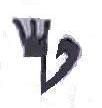The moshav of tes and other letters
 What is the law in regard to this tes? Is this a moshav, or that a tes
doesn't need a moshav? Or is it pasul?
What is the law in regard to this tes? Is this a moshav, or that a tes
doesn't need a moshav? Or is it pasul?
This question relates to other letters that have a moshav; lamed, kuf, mem
psucha, samech. Another problem is in regard to shin, the shin has a moshav
that is sharp not wide (as written in BY), what about a shin [like this] that
has 3 lines connected to the bottom point but there seems to be no moshav?
In many Sfardi scripts it is common to see samechs, that are triangle at
their bottom [sharper than the picture given] the lamed and kuf are without a
moshav. But maybe for ashkenazic script this isn't accepted?
[the second picture is a mixup of different csavim, but at least shows a sfardi kuf - without a moshav]
The Mishnat Sofrim [see Biur Hallacha in each of the letters] lamed, kuf clearly holds that they must have a moshav, if not are pasul. The Mikdash
M'at on lamed agrees to the MS that a lamed lacking a moshav is pasul (it seems
that he disagrees on the kuf). But I don’t know what they would say in regard
to the mem, tes and samech that lack a moshav?
But at least we see the MS opinion that a kuf or lamed written so as Sfardi
script, are not accepted for ashkenazi.
In Mishnat Hasofer [R. Shtern] Biur Hasofer p. 79 (ד"ה שתהיה עגולה) p.88 (ד"ה
הראשון) holds that this type
of triangular bottom in samech, shin, or tes are kosher, although not correct
lechatchila even in Sfardi script. He holds that these thin and sharp bottom edges
are considered a moshav – so these letters are not lacking a moshav. [This can
allow even the MS to accept these types of moshav in the letters samech, shin, tes, for the reason Mishnat Hasofer gives. However note addition at end of this post].
Further the Mishnat Hasofer disagrees with the MS psak in regard to
lamed and kuf that they are pasul if lacking a moshav, and paskens according to
other acharonim that the kuf is kosher [p. 87, according Avnei Nezer, Maharsham,
Mikdash Me'at], and in regard to lamed [p. 70, Biur Hasofer ד"ה
וכפוף] he compromises that if
the right foot comes straight down [as a reish] it is pasul [as the MS & MM],
but if it bends (slanting inward) like the true Sfardi lamed although there is no moshav it is
kosher.
In regard to the mem psucha he writes [p. 72, Yalkut Hasofer] that it is
pasul if lacking a moshav. He doesn’t explain – But I think, that mem is an
exception from the other letters mentioned, because a mem lacking a moshav is
not a mem at all – the mem both the psaucha & stuma must have 4 walls
[sides] to the letter. (this seems to be pashut also from the Mikdash M'at (mem,
par. 6) that the chartum has to be long enough that it could lock. So obviuosly
there must be a moshav to lock the chartum into)
[I must note that the wording of the BY on tes – גופה משוך
תחתיה באלכסון seems
to mean that the moshav of its caf is not flat [parallel to the sirtut] but on
a slant somewhat like the moshav of the ayin. Although the tes in question
lacks even this moshav].
The svara of Biur Hasofer to accept a triangular moshav for samech, tes, seems to contradict what I wrote in Shiyur Moshav of the lamed #2 that according MB there should be a shiur for the moshav, a MOK.
But obviously, the Biur Hasofer doesn't pasken like the MB in regard to the moshav of a lamed, as explained here.
The svara of Biur Hasofer to accept a triangular moshav for samech, tes, seems to contradict what I wrote in Shiyur Moshav of the lamed #2 that according MB there should be a shiur for the moshav, a MOK.
But obviously, the Biur Hasofer doesn't pasken like the MB in regard to the moshav of a lamed, as explained here.





Did you see the new picture I posted under the post "yuds with long tagim" do you think it is a mini lamed? The regel of the yud (does not have a moshav) however I think is like a sefardi lamed (at least according to the mishnat hasofer here).
ReplyDeleteDovid,
ReplyDeleteit is worthwhile highliting your addition so people will notice!